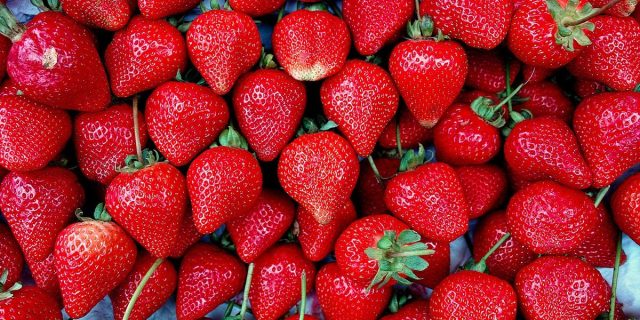01
Mar
Strawberries Lose Their Sweetness, Aroma, and Taste after Being Sprayed with Chemical Fungicides, Study Finds

(Beyond Pesticides, March 1, 2023) Fungicides sprayed on chemically farmed strawberries reduce their flavor quality, according to research published in the Journal of Agricultural and Food Chemistry this week. This explanation is a major insight for frustrated consumers who may remember when the strawberries sold at retail contained deeper, more complex flavors. As the agrichemical industry claims that dangerous pesticides are needed to grow food to feed the world, it is evident these practices health and environmental hazards, but also affect the quality of the food grown. As savvy shoppers and gardeners already know, buying and growing organic addresses this range of issues, improving flavor while protecting wildlife and public health.
Scientists developed their study to better understand the mechanisms leading to flavor deterioration by growing strawberry plants in a greenhouse with chemical-intensive practices, including the use of synthetic fertilizers. One group was treated with the fungicide boscalid, another with the fungicide difenconazole, and a control group received no spray. Fruits were sprayed beginning at the green, small fruit stage, a total of two times, and collections from each group were taken at the white, turning, and red fruit stage (zero, three, and seven days after the second pesticide application). Â Analysis was conducted on a range of variables, including fruit weight and size, total soluble solids, the fruit sugar-acid ratio, content of flavonoids, phenols, evidence of stress biomarkers, and volatile compounds. Red ripe fruits from each group were also blind taste tested by a panel of 30 individuals for a range of flavor attributes.
Differences in fruit weight and size are not significant between any of the groups. Sugar content increases through ripening as expected for all treatments, but the control group ripe strawberries contain the most sugars (with fructose being the highest content). Differences in sugar content are not minute, with the difenconazole expressing 10% less fructose, and boscalid group 25% less. Â At the same time, levels of titratable acid increase in the fungicide treatments, and display the lowest sugar-acid ratio; the control group expresses the highest. Â
Treated strawberries show lower levels of flavonoid content and a lower number of total phenols compared to the control. Analysis found evidence that treated strawberries also have higher levels of oxidative stress. In regards to volatile compounds produced by the fruits, fungicide treated fruit only showed higher levels associated with acids. Measurements of esters, aldehydes, furanones, and terpenes all see a marked decrease after fungicide applications.
The taste testing panel generally reflects the findings of the scientific analysis. All groups score roughly the same on how ripe, fresh, juicy, and firm the strawberry is. However, fungicide-treated groups score lower on aroma, and the acid intensity of the sprayed strawberries are rated higher. The control group resulted in the highest selection score, followed by the difenconazole and then boscalid-treated group.
For fungicide-treated strawberries, sugars are turned to acids, reducing sweetness, and changes in volatile compounds further reduce aroma and taste. Â
These data add another reason to avoid chemically grown products. In many ways, this is the theme of chemical farming – in trying to simplify rather than embrace the complexity of the environment and growing conditions, this approach makes for a bland and increasingly dull world.
In addition to flavor, organic products are also the healthier option. Organic dairy products have been found to be healthier than those produced through chemical-intensive management practices by increasing the proportion of beneficial amino acids. Even processed organic products represent a better choice over their chemical-intensive counterparts. According to recent data, even switching from a highly processed diet to one rich in fruits, vegetables and nuts is compromised by the presence of pesticides, potentially tripling exposure. Eating organic reduces exposure to pesticides, according to a report by the American Academy of Pediatrics. And research shows that organic food consumption is associated with higher scores on cognitive tests.
Help grow the organic movement, and enshrine practices that lead to healthier, tastier food by participating in Beyond Pesticides’ action alerts aimed at maintaining and improving organic integrity. See the webpage on Organic Agriculture for more information.
All unattributed positions and opinions in this piece are those of Beyond Pesticides.
Source: Journal of Agricultural and Food Chemistry, Phys.org










